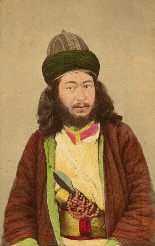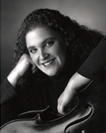An American in Istanbul
The Ancient Middle Eastern Modes
of the Yeni Makam Series by Edward J. Hines
1. Background

Edward J. Hines |
During late 1985 and most of 1986, I had the good fortune to live and study in Istanbul, Turkey, as the result of a generous grant from the Fulbright Foundation. The award, which was given only after consideration by separate committees from both the United State and Turkey, was to study the theories of Turkish classical and folk music and then to use those findings in newly composed Western-style works. |
The idea of a classically trained Western composer using material from another culture (especially the Middle East) as the basis for new works is not a new one.
Bartok is a perfect example. Another, perhaps more popular example is Mozart with his wonderful Rondo Alla Turca. In the years following the Fulbright, I discovered the real impact of the Alla Turca in late eighteenth and early nineteenth century European compositions. It was,
in fact, widespread and profound, especially in operatic works.
The Ottoman Turkish empire occupied all of southeastern Europe, the Middle East and North Africa and was a political force which could not be ignored. After
the failed siege of Vienna in 1684, Europeans looked at their Islamic neighbor to the East with less trepidation and more fascination and began imitating various aspects of Turkish culture. There were Turkish style cafes, baths and it even became fashionable to dress like a
‘Turk’ at parties. And, of course, Mozart, Beethoven and others found reason to bring the Turkish sound to their compositions.
Interestingly, the major contribution of the Turks was rhythmic and instrumental, less melodic. The Janissaries, the elite corps of the Ottomans, toured Europe, fascinating the West with their unusual sounding percussion instruments: cymbals, bass drums, bell trees and triangles. The use of percussion batteries then became an innovation in eighteenth-century orchestral
writing.
The Turkish march, which can be described as long-long, short-short-short or two half-notes followed by three quarters and a rest, is the main Turkish rhythm to come from this era, and is the focus of Mozart’s Rondo Alla Turca, among other works. It has survived to this day as a common pattern in military style marching.
The melodic impact was less profound, and was mostly limited to the stereotypical use of the harmonic minor to give an Eastern “Arabic” or “Turkish”
feel. Not much has really changed in this regard.
But a closer look at the folk and classical music literature from this region opens up a wide field
of research in history, philosophy and theory. The sound which we commonly identify as Middle Eastern -- Turkish and Arabic -- sounds the way it does for a reason, and understanding those reasons has been the focus of my work for over fifteen years. The history of the sound can be traced back six hundred years to the beginning of the Ottoman Empire, back even further to the Arabic Empire of the first millennium and finally, back to the work of the Pythagoreans of ancient Greece. |

Dervish
Circa 1900 |
The Arabs, Turks, and the West all recognize
Pythagorean scales as the essential element in the development of melodic thinking. It is the interpretation of Pythagorean scales -- the theory -- which has led to what might be called a Western, Turkish, or Arabic musical dialect. The three groups all work from the same basis, but have evolved differently over the centuries.
In the West, we see the early development of modes which then lead to the wide use of major and minor scales in composition. The added development of equal temperament enabled the West to explore and fully exploit the vertical side of composition, harmony, along with the horizontal side -- melody. Arabic and Turkish compositions also utilize a series of modes, known as maqamat in Arabic and makams in Turkish. Makams (maqamat) are based on the same Pythagorean principles of
construction as Western modes and scales. Makams, however, predate equal temperament, and closely reflect ancient intonations with an eastern approach.
Classical Turkish composers and performers regarded makams as rules of composition rather than as simply scales. While any makam can be reduced to scale form, their application is most significant in the context of a melody. In this context the tonic and dominant are central, as in Western modes and scales. The ancient intonations of makams appear at different scale degrees, according to the particular makam in use, and are microtonal in measurement. The result is a diatonic melody containing a pitch or pitches which are out of tune by standards of equal temperament. But to
the trained ear, makams are a highly organized approach to pitch interpretation which lead to a variety of colors and sensations.
It is worth noting that the equal temperament movement was a Western phenomenon and never influenced Middle Eastern composers who held onto the theories of their ancient predecessors. These theories embrace the
fundamental microtonal interval known as a Pythagorean comma (about one-eighth of a whole-tone) to produce makams (which are also microtonal),
which are then used to create compositions. Thus, understanding Middle Eastern composition means understanding the melodic complexities produced by
mictrotonal makams or maqamat (see http://www.hinesmusic.com/What_Are_Makams.html).
The difference between the modes and scales of the three dialects can be described by examining any one octave scale using whole-tones, half-tones, and the Pythagorean comma (one-eighth of a whole tone).
- Western: a series
equally tempered whole-tones and half-tones.
- Arabic: a series of whole-tones and half-tones with characteristic pitches augmented or diminished by one quarter-tone (2 Pythagorean commas).
- Turkish: a series of whole-tones and half-tones with characteristic pitches augmented or diminished by one-eighth of a whole-tone (1 Pythagorean comma) or by one
quarter-tone (2 Pythagorean commas).
2. The Yeni Makam Series
(New Modes)
An American in Istanbul is a new CD which features performances of the Yeni Makam Series, new works based on Turkish folk and classical music.
The works and performers include:

Oreet Ranon
Cellist |
•Yeni Makam 1 for solo bassoon, performed by
Steve Vacchi
•Yeni Makam 2 for solo violin, performed by Veronica Macchia-Kadlubkiewicz
•Yeni Makam 3 for solo cello, performed by Oreet Ranon
•Yeni Makam 4, duo for clarinet and percussion, Patrick O'Keefe clarinet, Terry Longshore percussion. |
Each of the works of Yeni Makam explores the ancient modal theories of makams from a Western perspective. The works are not Turkish music, but use Turkish music as a starting point. In some works themes from folk or classical Turkish works are borrowed and explored in
new ways. In other works, specific makams are the basis for a movement.
Still, in others, the characteristic pitches of specific makams are used to invent new pitches in a work. Cellist Oreet Ranon, who performs Yeni Makam 3 for solo cello on An American in Istanbul, describes it this way,
“ The nature of the classical Turkish modes used in the composition of these pieces is such that the sounds are unusual to many western ears. Intervals of the quarter-tone and eighth-tone are characteristic, along
with expressive slides/glissandi between certain notes. The result is marvelously stylized Eastern/Western classical music that is unique and different. “ The whole point of Yeni Makam is to bring these old traditions in a new context to Western performers.
Yeni Makam 3 is a chant, composed on the Saba makam in different transpositions. Saba is one of the older,
most gentle and poignant makams of the Middle East. The understated cries of Saba, derived in part from the nature of its structure, distinguish it from all other makams. It is a basic makam of both Turkish and Arabic music and is frequently used by muezzins in the daily chants of the Call to Prayer.
Note: In the following examples, the reversed flat sign with a slash -- -- indicates to lower the pitch by one quarter-tone:
-- indicates to lower the pitch by one quarter-tone:
The Saba makam is characterized by its lower tetrachord in minor mode, which contains second and fourth steps lowered by one quarter-tone (2 Pythagorean commas).The first section of Yeni Makam 3 is Saba centered on A:

The second section of the work stays completely within the range of a Saba tetrachord centered on the note D. The section juxtaposes D-natural and D-quarter-tone-flat in a meditative free-chant style:

In section three, the chant opens up into full voice and is also built on D. However the range is now extended to include B-flat:
 View sheet music sample from Yeni Makam 3
Download mp3 sample of Yeni Makam 3
View sheet music sample from Yeni Makam 3
Download mp3 sample of Yeni Makam 3
Stereo.mp3 excerpt 0:52, 812k
The fundamental principle of the development of Turkish classical music may be expressed as the cultivation of its melodic side on the basis of the Pythagorean theory. In this direction the Turks have gone farther than all the Oriental peoples and their experiment in this sphere should be studied since it very probably will be exploited in the future development not only of the melodic, but of the harmonic music of the world.
- Victor Belaiev, Turkish Music, The Musical Quarterly, July, 1935
Composer and publisher Edward J Hines is the owner of Edward Hines Music and is a co-founder of the group ANATOLIA, playing the folk songs and dance music of Turkey and the Arab world.
Visit http://www.hinesmusic.com for more information about sheet music for Yeni Makam 3 (solo cello), the CD An American in Istanbul, or for information about school programs on Turkish and Arabic music.





